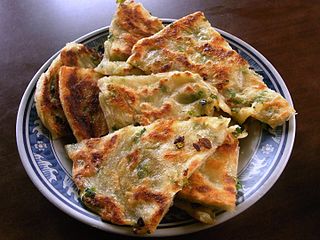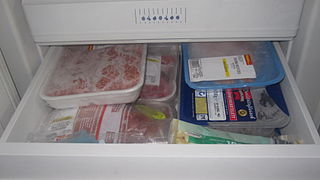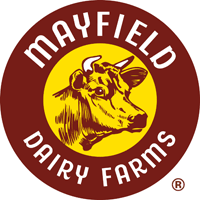
A potato chip is a thin slice of potato that has been either deep fried, baked, or air fried until crunchy. They are commonly served as a snack, side dish, or appetizer. The basic chips are cooked and salted; additional varieties are manufactured using various flavorings and ingredients including herbs, spices, cheeses, other natural flavors, artificial flavors, and additives.

A mint or breath mint is a food item often consumed as an after-meal refreshment or before business and social engagements to improve breath odor. Mints are commonly believed to soothe the stomach given their association with natural byproducts of the plant genus Mentha. Mints sometimes contain derivatives from plants such as peppermint oil or spearmint oil, or wintergreen from the plant genus Gaultheria. However, many of the most popular mints citing these natural sources contain none in their ingredient list or contain only trace amounts.

Cup Noodles is a brand of cup instant ramen developed in 1971 and manufactured by Nissin. Single servings of the product are packaged in foam, plastic, or paper cups and are prepared by adding boiling water.

Grāpple is the registered brand name for a commercially marketed brand of Fuji or Gala apple that has been soaked in a solution of concentrated grape flavor and water in order to make the flesh taste like a Concord grape. This solution does not add additional sugars or caloric content, nor does it affect the nutritional value of a standard apple. All ingredients are approved by the US Department of Agriculture and the US Food and Drug Administration, with the production process licensed by the Washington State Department of Agriculture.

Sous vide, also known as low temperature long time (LTLT) cooking, is a method of cooking in which food is placed in a plastic pouch or a glass jar and cooked in a water bath for longer than usual cooking times at a precisely regulated temperature.

Plastic wrap, cling film, Saran wrap, cling wrap, Glad wrap or food wrap is a thin plastic film typically used for sealing food items in containers to keep them fresh over a longer period of time. Plastic wrap, typically sold on rolls in boxes with a cutting edge, clings to many smooth surfaces and can thus remain tight over the opening of a container without adhesive. Common plastic wrap is roughly 0.0005 inches thick. The trend has been to produce thinner plastic wrap, particularly for household use, so now the majority of brands on shelves around the world are 8, 9 or 10 μm thick.

A squround is a container whose shape is between a square and a round tub. It resembles an oval but is sometimes closer to a rectangle with rounded corners. These allow the contents to be easily scooped out of the container. The name is a portmanteau for "square round" (cartons), referring to a compromise between a square and a round carton. It is also sometimes known as the scround.
Saran is a trade name used by S.C. Johnson & Son, Inc. for a polyethylene food wrap. The Saran trade name was first owned by Dow Chemical for polyvinylidene chloride (PVDC), along with other monomers. The formulation was changed to polyethylene in 2004 due to the problematic chlorine content of PVDC.

A field ration is a type of canned or pre-packaged military ration. They are distinguished from regular garrison rations by virtue of being designed for minimal preparation in the field, using canned, vacuum-sealed, pre-cooked or freeze-dried foods, powdered beverage mixes and concentrated food bars, as well as for long shelf life. Most field rations typically contain meat as one of their main courses. The iron ration is a soldier's dry emergency rations.
Scalping is the practice of removing the scalp of a defeated enemy as a trophy.

Cong you bing (cōngyóubǐng), also known as scallion pancake or "green onion pancake" is a Chinese, savory, unleavened flatbread folded with oil and minced scallions. Unlike Western pancakes, it is made from dough instead of batter. It is pan-fried which gives it crisp edges yet also a chewy texture. A unique characteristic of scallion pancakes is the many layers that make up the interior, which help contribute to its chewy texture. Variations exist on the basic method of preparation that incorporate other flavors and fillings.
During the height of their popularity ('89–'93) the Teenage Mutant Ninja Turtles (TMNT) had a vast number of food tie-ins ranging from inevitable to obscure, many of which have become very rare, with some fans looking for the food packages to many of these items.

Naked Juice is an American brand that produces juices and smoothies. The company is based in Monrovia, California and is owned by PepsiCo. Naked Juice Co. of Glendora, Inc. operates as a subsidiary of PepsiCo, Inc. The first Naked Juice drink was produced in 1983 and sold in California under the name "Naked Juice", referring to the composition of no artificial flavors, added sugar, or preservatives. Distribution has since expanded, and Naked Juice products are distributed in the United States, as well as in Canada, the United Kingdom, the Netherlands and France, among others.

An overwrap or wrap is applied over an item or is applied over another form of packaging. It is often made of plastic film or paper. It is typically used to protect products, but can be used decoratively.

Mayfield Dairy Farms is a United States dairy products company, with its headquarters in Athens, Tennessee and additional production plants in Birmingham, Alabama, and Braselton, Georgia. Since 1990 it has been under the ownership of Dean Foods.

Vacuum packing is a method of packaging that removes air from the package prior to sealing. This method involves placing items in a plastic film package, removing air from inside and sealing the package. Shrink film is sometimes used to have a tight fit to the contents. The intent of vacuum packing is usually to remove oxygen from the container to extend the shelf life of foods and, with flexible package forms, to reduce the volume of the contents and package.
Aseptic processing is a processing technique wherein commercially thermally sterilized liquid products are packaged into previously sterilized containers under sterile conditions to produce shelf-stable products that do not need refrigeration. Aseptic processing has almost completely replaced in-container sterilization of liquid foods, including milk, fruit juices and concentrates, cream, yogurt, salad dressing, liquid egg, and ice cream mix. There has been an increasing popularity for foods that contain small discrete particles, such as cottage cheese, baby foods, tomato products, fruit and vegetables, soups, and rice desserts.

Disposable food packaging comprises disposable products often found in fast food restaurants, takeout restaurants and kiosks, and catering establishments. Food-serving items for picnics and parties are very similar. Typical disposable foodservice products are foam food containers, plates, bowls, cups, utensils, doilies and tray papers. These products can be made from a number of materials including plastics, paper, bioresins, wood and bamboo.
Chocopunch is a popular name-brand retail confection product made in Peru under the Winter's brand owned by Compañía Nacional de Chocolates de Perú S.A. The Chocopunch brand was registered in Peru in 1995 and started production in 1997 by Lima-based Good Foods S.A. which was purchased on February 1, 2007 by Colombia-based Grupo Nacional de Chocolates through its Peruvian subsidiary Compañía Nacional de Chocolates de Perú S.A. . Compañía Nacional de Chocolates de Perú S.A. received a Class 30 international trademark registration for "Chocopunch" on December 17, 2007.

Overpackaging is the use of excess packaging. The Institute of Packaging Professionals defines overpackaging as “a condition where the methods and materials used to package an item exceed the requirements for adequate containment, protection, transport, and sale”














